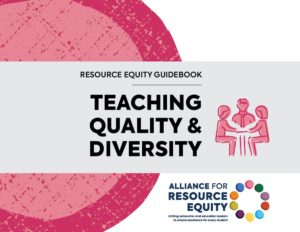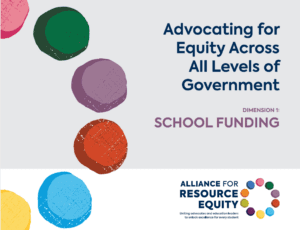The Vision
Each student—including students with higher needs and students of color—attends school in buildings that are structurally sound, provide a safe and appropriate physical environment for learning, and have effective equipment to meet student needs, so all students can reach high standards and thrive.
Sample Questions to Ask
- What are average scores on district-administered facilities condition assessments? Do scores differ across schools?
- What percentage of teachers in the district report being able to access high-quality equipment (like labs, technology, and classroom furniture) for all students who need it?
- How do teachers’ reports of access to high-quality equipment differ across student groups and/or across schools?
See our DIY District Diagnostic for more examples and recommendations about the types of data to look at.
Take Action With Our Diagnostic Tools
- Use our Resource Equity Diagnostic: Self-Assessment tool to start conversations and build shared understanding across teams.
- Then, analyze your data to better understand the state of resource equity in your district. First, use our Diagnostic Blueprints to learn about what types of analyses to conduct. Then, input your district data into our DIY Analysis Tools to complete these analyses and make meaning of the results.
- Prioritize areas for further inquiry and identify potential root causes and actions using our District Guidebook.
Common Causes of Inequity
- Insufficient Funding: When overall funding levels are insufficient or inflexible, it can limit a district’s capacity to maintain high-quality learning facilities and equipment for all students.
- Lack of Public Engagement & Accountability: Without consistent, equitable, and transparent community engagement in decision-making, learning facilities will not meet the needs of students and families.
- Limited Staff Capacity & Expertise: Without the necessary time or expertise, staff may find it challenging to effectively use equipment and technology in ways that facilitate students’ learning and meet their distinct needs.
Related Dimensions
No single dimension of education resource equity can unlock every student’s potential—but when dimensions are combined to meet students’ distinct needs, they are a strong foundation for unlocking better, more equitable experiences in school.
Explore the Empowering, Rigorous Content dimension because learning environments and equipment are influenced by the courses and curricula offered, and must be accompanied by high-quality instructional materials.
Toolkit
Use our Resource Equity Toolkit to learn more, start a conversation, and take action in your community.

The Education Combination
Learn about education resource equity by discovering 10 dimensions that unlock better, more equitable experiences in school for all students.

Diagnostic Tools And Supports
Identify strengths and gaps in your school system across all 10 dimensions.

Guidebooks
Explore underlying causes of your school system’s challenges and possible actions to improve students’ experiences in school.

Advocating Across Government
Identify who has the power to address equity gaps in your school system and the school district, state and federal levels.

Casemaking Decks
Develop compelling and coherent messaging to “make the case” for addressing resource inequities in your community.
